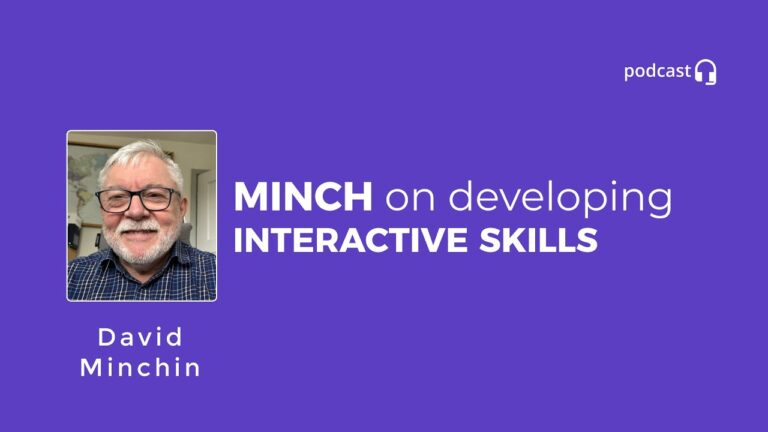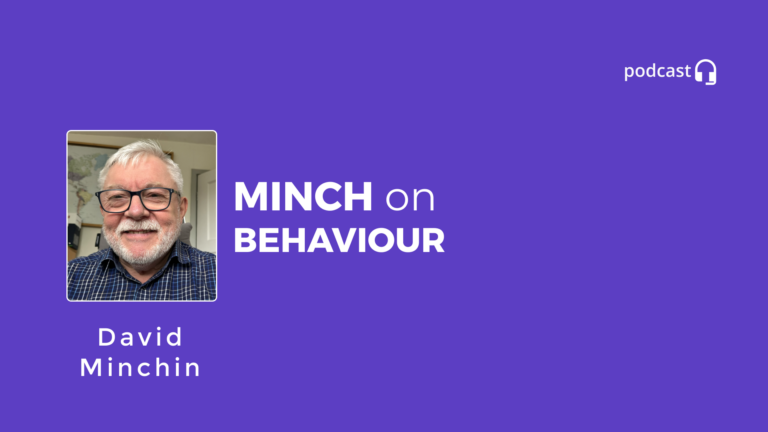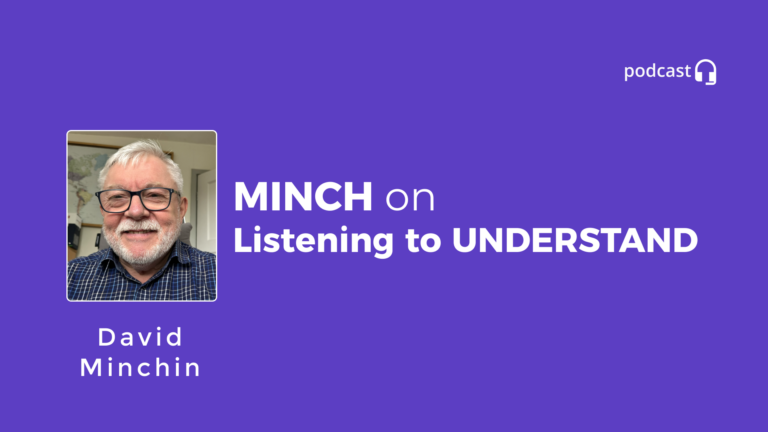MINCH on Behaviour Modification
by David Minchin
So, what is Behaviour Modification or BMod for short?
It is a problem solving approach, introduced to me by Peter Honey, Occupational Psychologist back in the day. As the title suggests, it can be used to analyse and solve problems that results from the way people behave.
What are people problems? A problem is the difference between what you’ve got and what you want. How often have we grumbled about other people’s poor performance or are we disappointed that someone is negative, or arkward or un-co-operative?
Further grumbles about people being resistant to change, autocratic, lazy, disorganised, or aggressive. These behaviours can be commonplace in many work environments and in other settings.
So people problems occur whenever there is a difference between the behaviour you want and the behaviour you’ve got.
Hey, non of us are perfect, I’ve had my times … I can be very awkward if I choose to be!
Perhaps I should produce a future Episode MINCH on How to be Really Awkward 🙂 or maybe not.
But have a listen to the episode MINCH on Behaviour Modification which is shorter than this article, probably better for anyone who prefers ‘Big Picture’.
Here are some of the traditional methods used to deal with people problems.
The pep talk
Sometimes this works but often improvements are short lived. The pep talk is totally inadequate in solving the more entrenched, persistent people problems, mainly because it leaves all the management of the change to the person displaying the issue.
Sending the individual away for training.
Popular because it temporarily gives the problem to someone else – The trainers who run the training. Unfortunately the effects of the training course dissipate rapidly if the work situation is hostile or apathetic to the changes.
Punishing the Individual
Punishing people leads to all sorts of unwanted side-effects. Punished people can become downtrodden, resentful, overcautious, or rebellious. They spend too much time anticipating punishment and plotting to ‘get their own back’.
Getting rid of the individual.
Easier said than done. When it is done it doesn’t actually solve anything apart from spreading performance problems around. Getting rid of a poor performer is an admission of defeat rather than any kind of solution.
So, what’s wrong with the traditional ways of tackling people problems?
Well, they have a poor track record of success and frequently skate around the problem rather than tackling it ‘head on’.
Often times, people problems are actually ignored and left to fester, sometimes for years. Just becomes accepted as part of that individuals ‘make up’.
Apart from ignoring people problems and hoping they will go away, what are the traditional ways of trying to solve them?
So, why is BMod more likely to be successful?
The main advantage is that BMod deals with tangible observable things. It avoids getting stuck in the underlying complications like attitudes, motives and feelings. The approach doesn’t deny the existence of these internal events, merely that when it comes to solving people problems they just complicate the issue. They tempt us into ‘problem solving dead ends’. Here are a few …Dead ends
- It’s his personality
- What can I do about it?
- It’s too big, I don’t know where to start.
- She isn’t interested
- He’s got the wrong attitude!
- He isn’t motivated.
- There isn’t a problem.
- She’s just plain awkward.
- It’s hopeless – just get rid of him.
- It’s just the way he’s made.
The BMod approach avoids these ‘dead ends’ by concentrating attention on people’s actions (their behaviour) rather than attitude, personality etc. It’s optimistic rather than pessimistic about finding workable solutions to all problems stemming from people’s behaviour.
The features of the BMod approach are as follows.
- It focuses on actual, observable behaviours rather than vague things like attitudes and underlying feelings.
- It pinpoints when the behaviour in question occurs by seeking to establish what triggers it.
- It establishes what results the behaviour in question produce by seeking to find out what encourages the behaviour to continue.
- Having analysed the events surrounding the behaviour in question, it goes on to develop a workable modification strategy.
- It is relatively easy to monitor the strategy, see if it is working and make adjustments to it as necessary.
Bmod isn’t magic, but it is a problem solving approach that has worked where others have failed.
Basically BMod sets out to pinpoint three things:
- A specific behaviour that is undesirable because it is detrimental to the individuals performance.
- The external events that cue, or trigger, this behaviour.
- What payoff the behaviour results in for the individual in question.
The BMod approach concentrates first on identifying the links between these three elements and then on working out:
- What specific behaviour is desirable in the light of the individuals responsibilities.
- How existing cues can be changed to make the desirable behaviour more likely and the undesirable behaviour less likely.
- How the existing payoffs can be changed so that the desirable behaviour is encouraged and/or the undesirable behaviour discouraged.
The routine that follows can be used to analyse and produce a modification strategy for any problem caused by people’s behaviour.
Initially the steps in the routine are exclusively concerned with analysing the existing situation. That done, the routine moves on to consider feasible ways of modifying cues and /or payoffs.
Apparently this routine was tested many times over a long period and found to be easy to follow and entirely practicable.
- Centre your attention on the person whose behaviour is to be modified and list the ways in which he/she behaves that you consider disappointing.
- Check that each behaviour you have listed is specific enough and actually describes something the person overtly does. Cross out the things you have listed that aren’t behavioural.
- Check that each remaining listed behaviour actually impairs the person’s current job performance. Cross out things you have listed that aren’t obviously related to job performance.
- If you still have a number of behaviours on your list to choose between, select one of them for processing through the remaining steps of this routine. Try to select the one which is most obviously detrimental to the person’s job performance. Note down the selected behaviour, this is the behaviour you wish to modify. Now that you have pinpointed a behaviour you want to modify, in most cases this is as far as you should go on your own. Unless there are exceptional circumstances, arrange to go through the remaining steps jointly with the individual concerned.
- Identify when the behaviour occurs by answering the question – What is the ‘cue’ that appears to trigger the behaviour? Note down the ‘cue’ immediately above the behaviour.
- Identify what happens immediately after the occurrence of the behaviour that is currently a satisfactory outcome for the person. Do this by answering the question ‘What is it in the current situation that makes the behaviour so satisfying to the person?’ This is the existing consequence. Note it down immediately under the behaviour.
- Having identified the links between the behaviour you wish to modify, it’s existing cue and it’s existing consequence for the person, you are now ready to note down the behaviour that you wish to see in the person. This will usually be the reversal of the behaviour selected for modification at step 4.
- Having described the desirable behaviour, check that it is likely to result in sufficient improvements in performance. Do this by listing the performance related benefits that you anticipate the modified behaviour will lead to. If you are clear that the modified behaviour will result in a satisfactory number of performance improvements, work out a modification strategy by proceeding with subsequent steps.
- If, however, you are uncertain that the desired behaviour defined in step 7 will result in sufficient improvements of performance, abandon it, and select a new required behaviour that meets more of the anticipated benefits.
- Decide whether it is feasible to change the cue by looking back at the cue you identified in step 5 and answering the question ‘Is there anything I can do to alter the existing cue so that the likelihood of triggering the desired behaviour is increased?’ List any action you can think of.
- In addition, look at the existing consequences identified in step 6 and answer the question ‘Is there anything I can do to reinforce the desired behaviour immediately after its occurrence, and/or to discourage the existing behaviour immediately after its occurrence? List any actions you can think of.
- Finalise your modification strategy by selecting the actions from step 10 and/or step 11 that you can commit yourself to. When making your selection check that it is feasible for you to implement the strategy.
- Finally consider how to launch your modification strategy. If you haven’t already been open with the person about the strategy, is it the time now to discuss your intentions?
Ideally working with the individual from the start would be the best way. However circumstances may dictate you implementing the strategy quietly. For example, if the person was likely to just work against you. This will depend on the Individual and the issue.
The BMod routine in Brief
- List all disappointing behaviours.
- Cross out items that aren’t behavioral.
- Cross out items that aren’t obviously related to job performance.
- Select the single most important disappointing behaviour.
- Write down the behaviour selected for modification.
- Identify the cues that trigger the disappointing behaviour.
- Identify payoffs that encourage the disappointing behaviour.
- Decide what behaviour you want.
- Check that the wanted behaviour is sufficiently beneficial.
- Work out how to alter the cues to discourage the disappointing behaviour and encourage the wanted behaviour.
- Do the same with the payoffs as in step 10 above.
- Select a feasible modification strategy.
- Work out how to implement the strategy.
As well as the article I will also provide a case study to demonstrate BMod in action.
Finally if this all sounds too clinical for you … think back to some of the traditional methods … this at least gives people the opportunity to improve by just adapting what we say, how we say it and what we do (our body language)
Anyway I think that is enough for now .
Thank you for reading … Stay curious and keep learning







